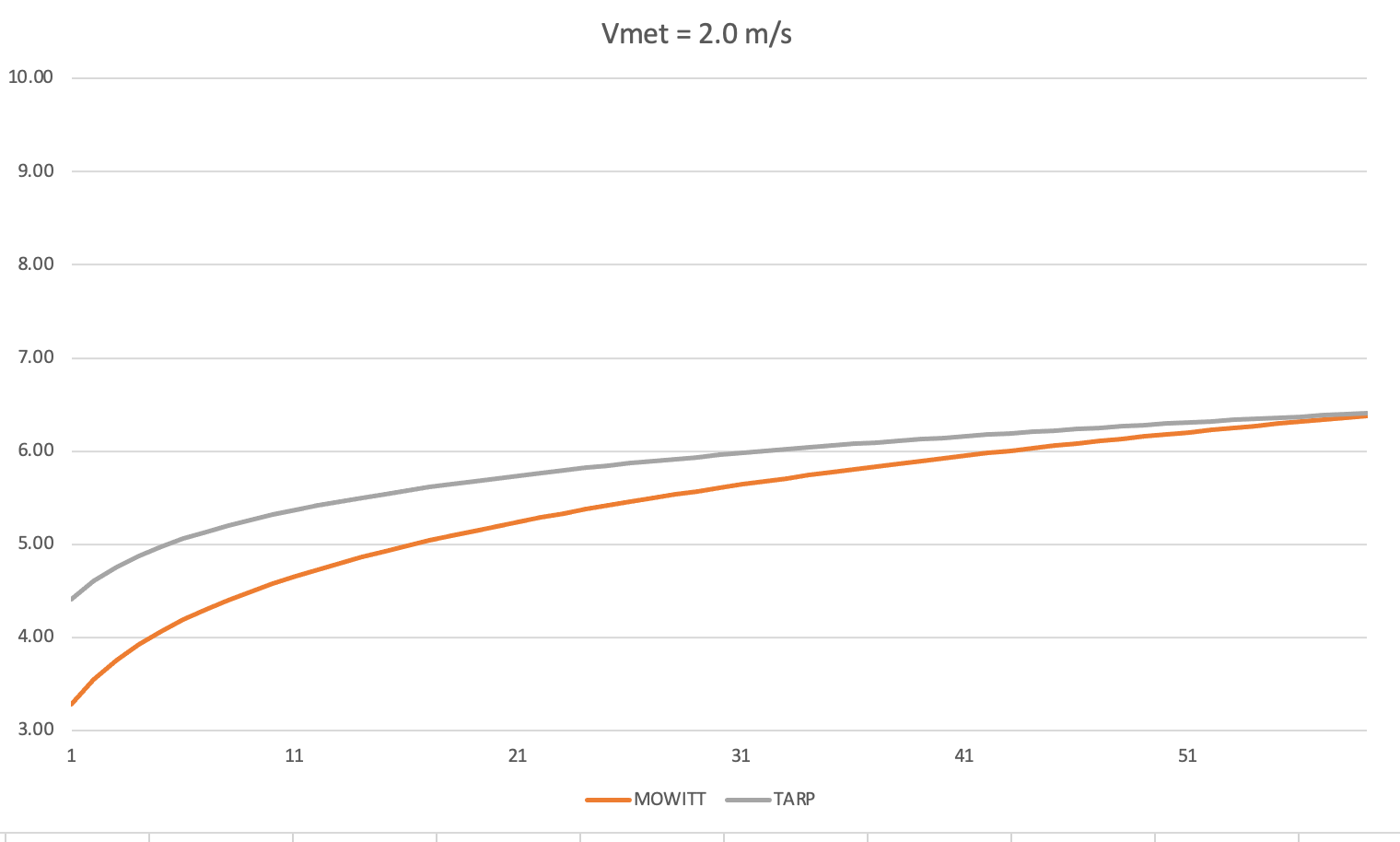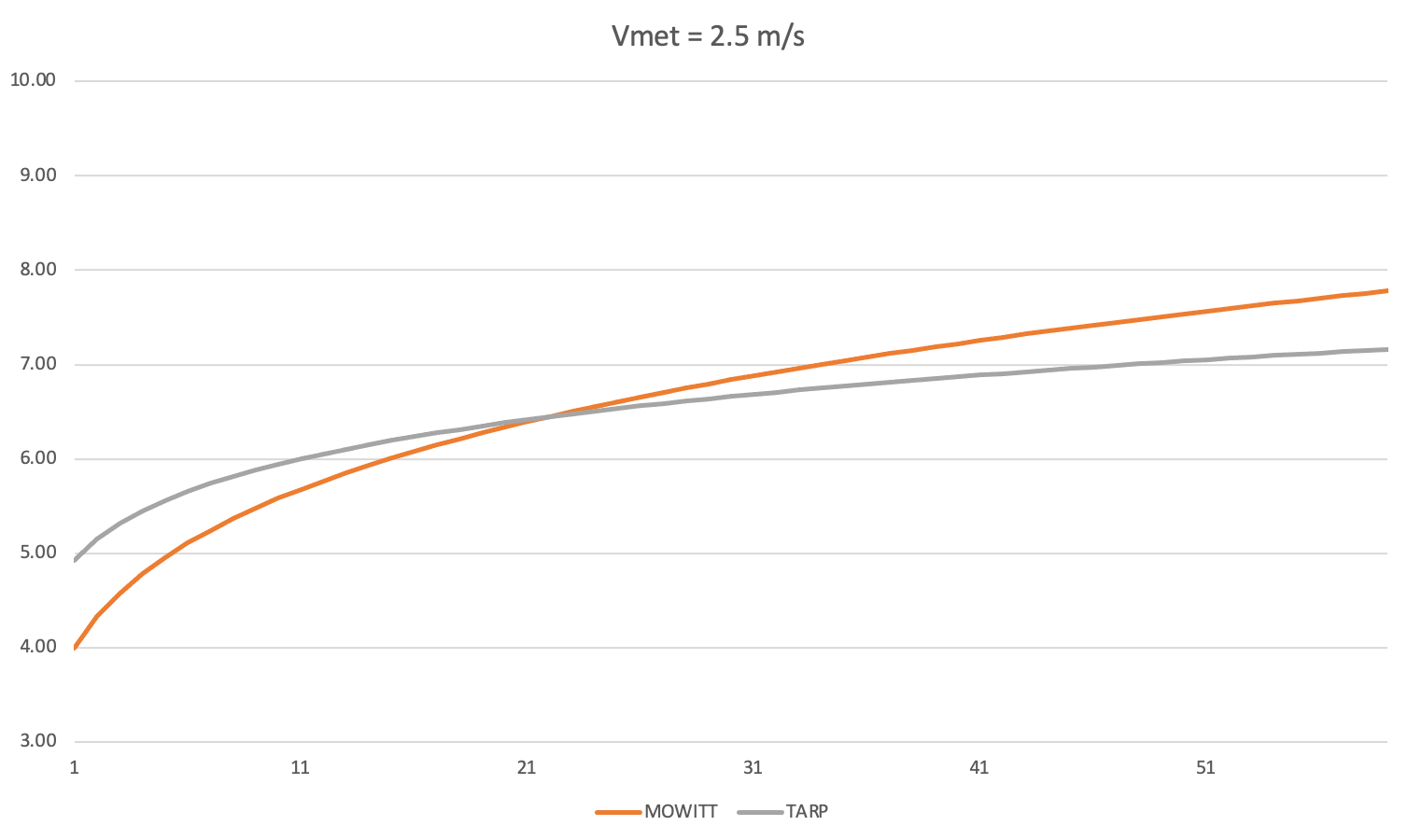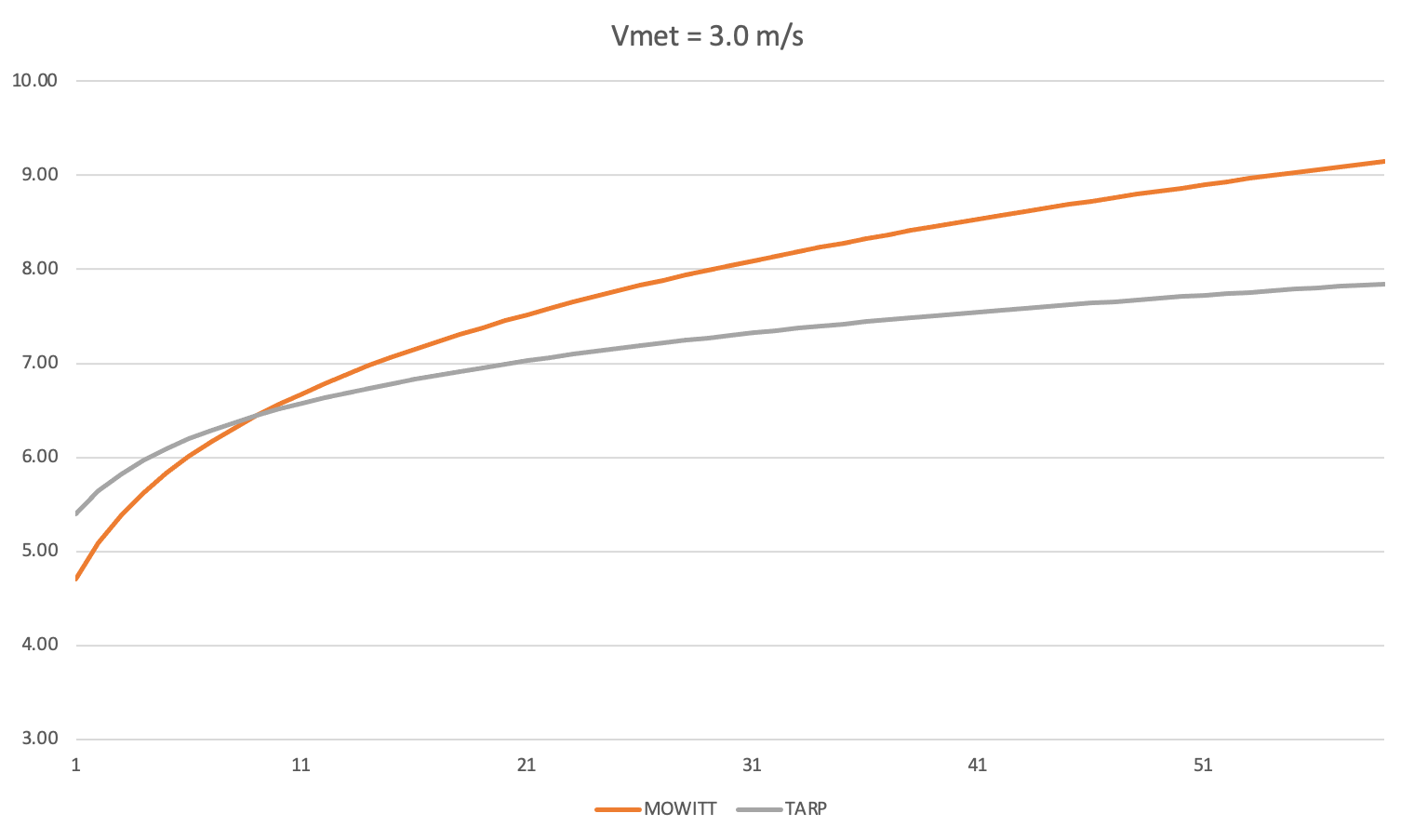First time here? Check out the Help page!
 | 1 | initial version |
Not a definitive answer - a few UMH people have direct, hands-on experience with this (hopefully they may chime in).
The following 3x plots may be helpful for your 2nd question: MoWITT vs TARP-predicted hf (forced convection, in W/m2.K ... Y-axis) for very smooth (windward) surfaces, as a function of local Vz (window height, up to 60m). Assuming default E+ weather station conditions (height = 10m, exponent 0.14, boundary layer thickness 270m), vs local building conditions similar to the original studies, further discussed here (exponent 0.22, boundary layer thickness 370m).
At low wind speeds at the weather station (Vmet 2m/s; Vz 1.4m/s @10m), IMHO it's fine to rely on MoWITT up to 60m: it's more conservative at lower heights (i.e. Yazdanian & Klems' thesis), and merges with TARP with increasing height. This is assuming a surface perimeter/area ratio of 3 for TARP (this has a significant impact on results).

At slightly higher wind speeds at the weather station (Vmet 2.5m/s; Vz 1.8m/s @10m), there's a crossover at ~20m. Hard to say if one should definitely switch to TARP above 20m, but it's giving you an idea of the range. Again, TARP's perimeter/area ratio is something to keep in mind (e.g. if it were 2 instead of 3).

Finally, at higher wind speeds at the weather station (Vmet 3m/s; Vz 2.2m/s @10m), the crossover is around 10m (roughly what Yazdanian & Klems would consider low-rise residential buildings, their target building type). The discrepancy between predictions starts to be somewhat significant at greater window heights (even without considering TARP's perimeter/area ratio). In my neck of the woods, average winter wind speeds (weather station) are around 4m/s. I'd likely avoid MoWITT above 4 or 5 stories. But I'm unsure what the alternative is really, given TARP's sensitivity to the perimeter/area ratio. I may have to take a deeper dive, as I can't get my head around this ratio when it comes to a fully-glazed, 10-storey buildings with silicon structural joints.

Long story short, it would seem to depend strongly on expected wind speeds. But low-rise, 3-storied residential buildings definitely seem to be the sweet spot for MoWITT.
I hesitate in answering your 1st question, as it's a bit confusing. Are you taking local wind speed measurements, and attempting to estimate hf for glazed surfaces nearby? If so, I'd resort to the initial local wind speed equation while trying to characterize your local wind environment. I may be misunderstanding the question ...
 | 2 | No.2 Revision |
Not a definitive answer - a few UMH people have direct, hands-on experience with this (hopefully they may chime in).
The following 3x plots may be helpful for your 2nd question: MoWITT vs TARP-predicted hf (forced convection, in W/m2.K ... Y-axis) for very smooth (windward) surfaces, as a function of local Vz (window height, up to 60m). Assuming default E+ weather station conditions (height = 10m, exponent 0.14, boundary layer thickness 270m), vs local building conditions similar to the original studies, further discussed here (exponent 0.22, boundary layer thickness 370m).
At low wind speeds at the weather station (Vmet 2m/s; Vz 1.4m/s @10m), IMHO it's fine to rely on MoWITT up to 60m: it's more conservative at lower heights (i.e. Yazdanian & Klems' thesis), and merges with TARP with increasing height. This is assuming a surface perimeter/area ratio of 3 for TARP (this has a significant impact on results).

At slightly higher wind speeds at the weather station (Vmet 2.5m/s; Vz 1.8m/s @10m), there's a crossover at ~20m. Hard to say if one should definitely switch to TARP above 20m, but it's giving you an idea of the range. Again, TARP's perimeter/area ratio is something to keep in mind (e.g. if it were 2 instead of 3).

Finally, at higher wind speeds at the weather station (Vmet 3m/s; Vz 2.2m/s @10m), the crossover is around 10m (roughly what Yazdanian & Klems would consider low-rise residential buildings, their target building type). The discrepancy between predictions starts to be somewhat significant at greater window heights (even without considering TARP's perimeter/area ratio). In my neck of the woods, average winter wind speeds (weather station) are around 4m/s. I'd likely avoid MoWITT above 4 or 5 stories. But I'm unsure what the alternative is really, given TARP's sensitivity to the perimeter/area ratio. I may have to take a deeper dive, as I can't get my head around this ratio when it comes to a fully-glazed, 10-storey buildings with silicon structural joints.

Long story short, it would seem to depend strongly on expected wind speeds. But low-rise, 3-storied residential buildings definitely seem to be the sweet spot for MoWITT.
I hesitate in answering your 1st question, as it's a bit confusing. Are you taking local wind speed measurements, and attempting to estimate hf for glazed surfaces nearby? If so, I'd resort to the initial local wind speed equation while trying to characterize your local wind environment. I may be misunderstanding the question ...
 | 3 | No.3 Revision |
Not a definitive answer - a few UMH people have direct, hands-on experience with this (hopefully they may chime in).
The following 3x plots may be helpful for your 2nd question: MoWITT vs TARP-predicted hf (forced convection, in W/m2.K ... Y-axis) for very smooth (windward) surfaces, as a function of local Vz (window height, up to 60m). Assuming default E+ weather station conditions (height = 10m, exponent 0.14, boundary layer thickness 270m), vs local building conditions similar to the original studies, further discussed here (exponent 0.22, boundary layer thickness 370m).
At low wind speeds at the weather station (Vmet 2m/s; Vz 1.4m/s @10m), IMHO it's fine to rely on MoWITT up to 60m: it's more conservative at lower heights (i.e. Yazdanian & Klems' thesis), and merges with TARP with increasing height. This is assuming a surface perimeter/area ratio of 3 for TARP (this has a significant impact on results).

At slightly higher wind speeds at the weather station (Vmet 2.5m/s; Vz 1.8m/s @10m), there's a crossover at ~20m. Hard to say if one should definitely switch to TARP above 20m, but it's giving you an idea of the range. Again, TARP's perimeter/area ratio is something to keep in mind (e.g. if it were 2 instead of 3).

Finally, at higher wind speeds at the weather station (Vmet 3m/s; Vz 2.2m/s @10m), the crossover is around 10m (roughly what Yazdanian & Klems would consider low-rise residential buildings, their target building type). The discrepancy between predictions starts to be somewhat significant at greater window heights (even without considering TARP's perimeter/area ratio). In my neck of the woods, average winter wind speeds (weather station) are around 4m/s. I'd likely avoid MoWITT above 4 or 5 stories. But I'm unsure what the alternative is really, given TARP's sensitivity to the perimeter/area ratio. I may have to take a deeper dive, as I can't get my head around this ratio when it comes to a fully-glazed, 10-storey buildings with silicon structural joints.

Long story short, it would seem to depend strongly on expected wind speeds. But low-rise, 3-storied residential buildings definitely seem to be the sweet spot for MoWITT.
I hesitate in answering your 1st question, as it's a bit confusing. Are you taking local wind speed measurements, and attempting to estimate hf for glazed surfaces nearby? If so, I'd resort to the initial local wind speed equation while trying to characterize your local wind environment. I may be misunderstanding the question ...
 | 4 | No.4 Revision |
Not a definitive answer - a few UMH people have direct, hands-on experience with this (hopefully they may chime in).
The following 3x plots may be helpful for your 2nd question: MoWITT vs TARP-predicted hf (forced convection, in W/m2.K ... Y-axis) for very smooth (windward) surfaces, as a function of local Vz (window height, up to 60m). Assuming default E+ weather station conditions (height = 10m, exponent 0.14, boundary layer thickness 270m), vs local building conditions similar to the original studies, further discussed here (exponent 0.22, boundary layer thickness 370m).
At low wind speeds at the weather station (Vmet 2m/s; Vz 1.4m/s @10m), IMHO it's fine to rely on MoWITT up to 60m: it's more conservative at lower heights (i.e. Yazdanian & Klems' thesis), and merges with TARP with increasing height. This is assuming a surface perimeter/area ratio of 3 for TARP (this has a significant impact on results).

At slightly higher wind speeds at the weather station (Vmet 2.5m/s; Vz 1.8m/s @10m), there's a crossover at ~20m. Hard to say if one should definitely switch to TARP above 20m, but it's giving you an idea of the range. Again, TARP's perimeter/area ratio is something to keep in mind (e.g. if it were 2 instead of 3).

Finally, at higher wind speeds at the weather station (Vmet 3m/s; Vz 2.2m/s @10m), the crossover is around 10m (roughly what Yazdanian & Klems would consider low-rise residential buildings, their target building type). The discrepancy between predictions starts to be somewhat significant at greater window heights (even without considering TARP's perimeter/area ratio). In my neck of the woods, average winter wind speeds (weather station) are around 4m/s. I'd likely avoid MoWITT above 4 or 5 stories. But I'm unsure what the alternative is really, given TARP's sensitivity to the perimeter/area ratio. I may have to take a deeper dive, as I can't get my head around this ratio when it comes to fully-glazed, 10-storey buildings with silicon structural joints.

Long story short, it would seem to depend strongly on expected wind speeds. But low-rise, 3-storied 3-storey residential buildings definitely seem to be the sweet spot for MoWITT.
I hesitate in answering your 1st question, as it's a bit confusing. Are you taking local wind speed measurements, and attempting to estimate hf for glazed surfaces nearby? If so, I'd resort to rely on the initial local wind speed equation while trying to characterize characterizing your local wind environment. I may be misunderstanding the question ...
 | 5 | No.5 Revision |
Not a definitive answer - a few UMH people have direct, hands-on experience with this (hopefully they may chime in).
The following 3x plots may be helpful for your 2nd question: MoWITT vs TARP-predicted hf (forced convection, in W/m2.K ... Y-axis) for very smooth (windward) surfaces, as a function of local Vz (window height, up to 60m). Assuming default E+ weather station conditions (height = 10m, exponent 0.14, boundary layer thickness 270m), vs local building conditions similar to the original studies, further discussed here (exponent 0.22, boundary layer thickness 370m).
At low wind speeds at the weather station (Vmet 2m/s; Vz 1.4m/s @10m), IMHO it's fine to rely on MoWITT up to 60m: it's more conservative at lower heights (i.e. Yazdanian & Klems' thesis), and merges with TARP with increasing height. This is assuming a surface perimeter/area ratio of 3 for TARP (this has a significant impact on results).

At slightly higher wind speeds at the weather station (Vmet 2.5m/s; Vz 1.8m/s @10m), there's a crossover at ~20m. Hard to say if one should definitely switch to TARP above 20m, but it's giving you an idea of the range. Again, TARP's perimeter/area ratio is something to keep in mind (e.g. if it were 2 instead of 3).

Finally, at higher wind speeds at the weather station (Vmet 3m/s; Vz 2.2m/s @10m), the crossover is around 10m (roughly what Yazdanian & Klems would consider low-rise residential buildings, their target building type). The discrepancy between predictions starts to be somewhat significant at greater window heights (even without (without even considering TARP's perimeter/area ratio). In my neck of the woods, average winter wind speeds (weather station) are around 4m/s. I'd likely avoid MoWITT above 4 or 5 stories. But I'm unsure what the alternative is really, given TARP's sensitivity to the perimeter/area ratio. I may have to take a deeper dive, as I can't get my head around this ratio when it comes to fully-glazed, 10-storey buildings with silicon structural joints.

Long story short, it would seem to depend strongly on expected wind speeds. But low-rise, 3-storey residential buildings definitely seem to be the sweet spot for MoWITT.
I hesitate in answering your 1st question, as it's a bit confusing. Are you taking local wind speed measurements, and attempting to estimate hf for glazed surfaces nearby? If so, I'd rely on the initial local wind speed equation while characterizing your local wind environment. I may be misunderstanding the question ...
